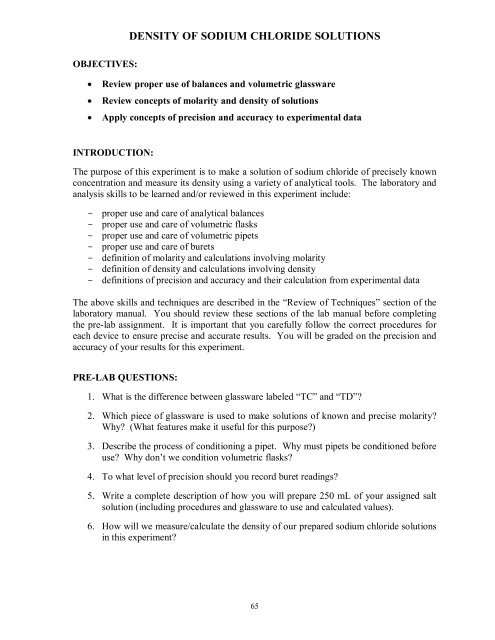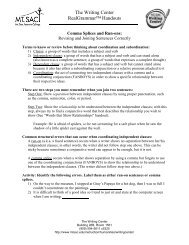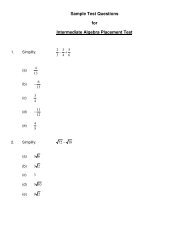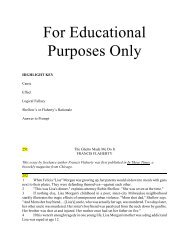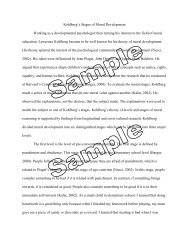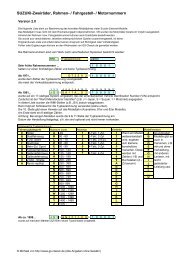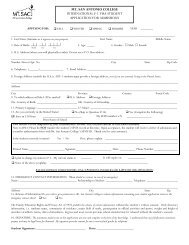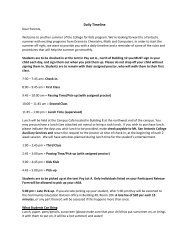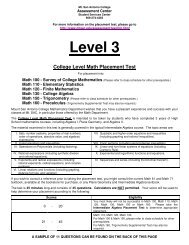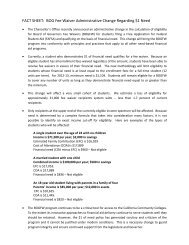DENSITY OF SODIUM CHLORIDE SOLUTIONS
DENSITY OF SODIUM CHLORIDE SOLUTIONS
DENSITY OF SODIUM CHLORIDE SOLUTIONS
You also want an ePaper? Increase the reach of your titles
YUMPU automatically turns print PDFs into web optimized ePapers that Google loves.
<strong>DENSITY</strong> <strong>OF</strong> <strong>SODIUM</strong> <strong>CHLORIDE</strong> <strong>SOLUTIONS</strong><br />
OBJECTIVES:<br />
<br />
<br />
<br />
Review proper use of balances and volumetric glassware<br />
Review concepts of molarity and density of solutions<br />
Apply concepts of precision and accuracy to experimental data<br />
INTRODUCTION:<br />
The purpose of this experiment is to make a solution of sodium chloride of precisely known<br />
concentration and measure its density using a variety of analytical tools. The laboratory and<br />
analysis skills to be learned and/or reviewed in this experiment include:<br />
- proper use and care of analytical balances<br />
- proper use and care of volumetric flasks<br />
- proper use and care of volumetric pipets<br />
- proper use and care of burets<br />
- definition of molarity and calculations involving molarity<br />
- definition of density and calculations involving density<br />
- definitions of precision and accuracy and their calculation from experimental data<br />
The above skills and techniques are described in the “Review of Techniques” section of the<br />
laboratory manual. You should review these sections of the lab manual before completing<br />
the pre-lab assignment. It is important that you carefully follow the correct procedures for<br />
each device to ensure precise and accurate results. You will be graded on the precision and<br />
accuracy of your results for this experiment.<br />
PRE-LAB QUESTIONS:<br />
1. What is the difference between glassware labeled “TC” and “TD”<br />
2. Which piece of glassware is used to make solutions of known and precise molarity<br />
Why (What features make it useful for this purpose)<br />
3. Describe the process of conditioning a pipet. Why must pipets be conditioned before<br />
use Why don’t we condition volumetric flasks<br />
4. To what level of precision should you record buret readings<br />
5. Write a complete description of how you will prepare 250 mL of your assigned salt<br />
solution (including procedures and glassware to use and calculated values).<br />
6. How will we measure/calculate the density of our prepared sodium chloride solutions<br />
in this experiment<br />
65
<strong>DENSITY</strong> <strong>OF</strong> <strong>SODIUM</strong> <strong>CHLORIDE</strong> <strong>SOLUTIONS</strong><br />
CHEMICALS AND MATERIALS<br />
NaCl(s)<br />
water<br />
EQUIPMENT TO BE CHECKED OUT<br />
5-mL graduated pipet<br />
250mL volumetric flask<br />
25mL buret<br />
25mL Erlenmeyer flask with stopper<br />
SAFETY<br />
Goggles must be worn in the laboratory.<br />
WASTE DISPOSAL<br />
All solutions may be rinsed down the sink<br />
EXPERIMENTAL PROCEDURE:<br />
Your instructor will assign you a specific molarity of sodium chloride solution to prepare.<br />
You will prepare 250 mL of this solution and then measure its density by weighing specific<br />
volumes of the solution on the analytical balance. Your instructor may assign one or all of<br />
the methods for determining density from steps 2-4 below.<br />
1. Prepare 250 mL of your assigned concentration of sodium chloride solution. Record<br />
the exact mass of sodium chloride used.<br />
2. Use your 5-mL graduated pipet to transfer 5.00 mL of your prepared solution to the<br />
25-mL volumetric flask (keep stopper on after transferring to avoid evaporation<br />
losses) and measure the mass of this solution on an analytical balance. Repeat this<br />
procedure until you have 5 consecutive trials that agree within 0.2% (or about 0.02 g).<br />
3. Use your 10-mL volumetric pipet to transfer 10.00 mL of your prepared solution to<br />
the 25-mL volumetric flask (keep stopper on after transferring to avoid evaporation<br />
losses) and measure the mass of this solution on an analytical balance. Repeat this<br />
procedure until you have 5 consecutive trials that agree within 0.2% (or about 0.02 g).<br />
4. Use a buret to sequentially transfer approximately 5 mL aliquots of your solution to<br />
the pre-weighed weighing vial and weigh the transferred solution (do not empty the<br />
weighing vial—add each additional 5mL to it). Repeat until you have delivered a<br />
total of 20 mL of solution to your weighing vial. Note that it is not important to<br />
transfer exactly 5.00 mL each time, but it is important to know precisely what volume<br />
of solution was transferred—record the exact buret readings.<br />
66
<strong>DENSITY</strong> <strong>OF</strong> <strong>SODIUM</strong> <strong>CHLORIDE</strong> <strong>SOLUTIONS</strong><br />
DATA ANALYSIS:<br />
(Your instructor may assign specific questions from those below depending on which<br />
procedural steps you completed.)<br />
1. Calculate the molarity of your sodium chloride solution from your experimental data.<br />
2. (From step 2 in the procedure) Calculate the density of density of your sodium<br />
chloride solution based on the measurements from the graduated pipet and analytical<br />
balance. Determine a density for each trial and also calculate the average density,<br />
standard deviation and relative standard deviation.<br />
3. (From step 3 in the procedure) Calculate the density of density of your sodium<br />
chloride solution based on the measurements from the volumetric pipet and analytical<br />
balance. Determine a density for each trial and also calculate the average density,<br />
standard deviation and relative standard deviation.<br />
4. (From step 4 in the procedure) Use Excel to make a graph of mass vs. volume for<br />
your measurements from the buret and analytical balance. Perform a linear fit of this<br />
data and include the equation of the line and the corresponding R 2 value in your plot.<br />
Use the equation of the line to find the average density of your sodium chloride<br />
solution from these measurements.<br />
5. (From steps 2 or 3 and 4 in the procedure) Calculate the percent difference between<br />
the average density determined using the graduated pipet or volumetric pipet and the<br />
average density determined using the buret.<br />
6. (From steps 2 or 3 in the procedure) Use the average density determined with the<br />
graduated pipet or volumetric pipet to calculate the % by mass NaCl in your prepared<br />
solution.<br />
7. (From steps 2, 3, 4 in the procedure) Obtain the “true value” for the density of your<br />
solution from the instructor and calculate the percent error for your pipet and buret<br />
determinations.<br />
POST-LAB QUESTIONS:<br />
1. (From steps 2 and/or 3 in the procedure) Does the experimental precision you<br />
obtained with the graduated pipet and/or volumetric pipet agree with the expected<br />
precision of the measurement based on significant figures Discuss.<br />
2. (From steps 2 and 3 in the procedure) Do the density results calculated from the<br />
graduated piper and volumetric pipet and buret agree within the precision of the two<br />
instruments Discuss.<br />
3. (From steps 2 and/or 3 in the procedure) Does the “true value” of the density of your<br />
prepared solution lie within the precision of your measurements for the graduated<br />
and/or volumetric pipet Discuss.<br />
67
<strong>DENSITY</strong> <strong>OF</strong> <strong>SODIUM</strong> <strong>CHLORIDE</strong> <strong>SOLUTIONS</strong><br />
REFERENCES:<br />
Written by Janet Truttmann, September 2010, Revised February 22, 2011 (Reviewed by<br />
Jenny Leung, Jody Williams-Tyler, Terri Beam)<br />
68


